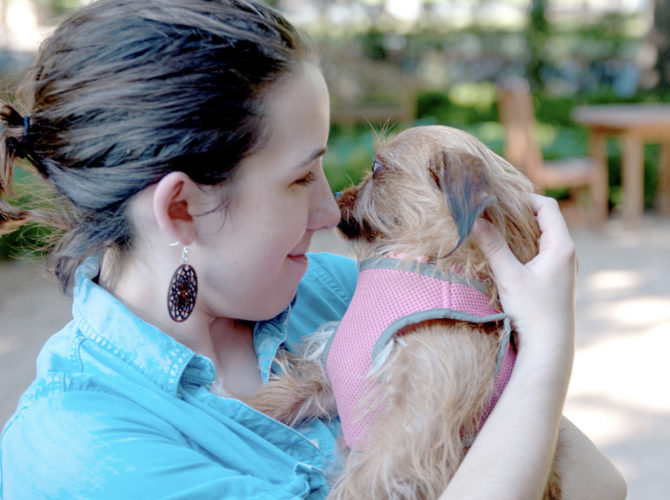Story by Meredith Wagner | Photo by Trey Honeycutt
Many who battle mental illness have been there — perched across from a well-dressed adult with a framed diploma mounted to the wall, fidgeting under the glow of an expensive, dimmed lamp. While traditional therapy has proven helpful for some, others hope for something else — something that allows for emotional support without being confined to one-hour-weekly sessions. In essence, human support doesn’t always cut it.
This is why Audrey Hamlin, and many others, have sought refuge and long-term healing in animal therapy. Hamlin found the help she needed in the comfort of a canine companion.
Diagnosed with post-traumatic stress disorder and suffering from regular insomnia and panic attacks, Hamlin experimented with multiple forms of therapy, but she never quite found the right fit. That is, until she adopted her dog, Gracie, a half dachshund, half wire-haired terrier.
“I don’t wake up at 3 a.m. with panic attacks anymore,” Hamlin said. “I could sleep for the first time in months.”
The connection Hamlin has with Gracie doesn’t stem from Gracie’s ability to give advice, to respond to Hamlin’s expressions of concern, or to offer anything material. The ability for an animal to connect with humans without saying a word is arguably what makes their presence so helpful in times of stress or anguish.
“When you’re having a panic attack, you don’t want to talk to anyone, but you also don’t want to be alone,” Hamlin said. “I never have to explain to Gracie what I’m feeling. She’s just there.”
After trial and error with medication, traditional therapy and a form of exposure therapy designed to help patients with PTSD, Hamlin said she found exactly what she needed in her furry friend.
“Gracie has been my long-term therapy solution,” she said. “A lot of the things I experienced in the first year of being diagnosed I don’t really deal with anymore.”
Gracie is classified as an Emotional Support Animal, or ESA. This means that Gracie is neither a service dog nor a therapy dog. It is important to establish the distinction between service dogs, therapy dogs and ESAs, because there are legal consequences for claiming that a dog is one or the other without proper training and paperwork.
Service dogs undergo rigorous training catered to an individual’s direct needs. Their abilities can encompass a wide range of tasks, from detecting potentially dangerous elements in the immediate environment, to notifying bystanders if a diabetic owner’s blood sugar level needs attention, to anticipating an owner’s approaching panic attack.
Therapy animals also undergo rigorous training. The defining factor that sets them apart is their overarching purpose in the community. Trained therapy animals often work in the community with their owners, serving groups of people instead of tending to an individual’s specific needs throughout the day. Therapy animals are trained to remain calm in stressful, loud and unfamiliar environments.
In contrast to certified service and therapy animals, emotional support animals do not need to undergo any training, and they are often recommended to an individual by a doctor. ESAs are not allowed the same freedom in society as service and therapy animals due to their lack of training. Despite this, Hamlin did not have to pay a pet deposit at her apartment, and she once took Gracie on an airplane after a recommendation from her doctor and approval from the airline.
“Sometimes people will get angry with me for having an ESA because they feel like I’m claiming to have a service animal when I don’t,” Hamlin said. “She is not a service animal. I will not literally die without her.”
Hamlin said while Gracie is not a trained service animal, she does provide her a service. In addition to catering to certain mental illnesses, animals can play a strong role in improving lives in general.
Angel Paws, a local nonprofit of 22 members and 33 certified therapy dogs, has served the Waco community for nearly 14 years, promoting the human-animal bond through the development of Animal-Assisted Activities/Therapy programs.
Angel Paws provides the opportunity for members of the Waco community to safely interact with dogs in a controlled environment, keeping each person’s mental, emotional and spiritual health in mind.
“We team up with dogs to bring joy to others,” said member Jean Wesley. “The dogs can do the things we cannot do.”
The dogs of Angel Paws undergo a comprehensive training process with their handlers. Each handler is the only one allowed to legally accompany his/her animal on community outings. Member Jean Ann Jones said this is because it is important for the dogs to learn to communicate with and trust their handler. If a situation becomes noisy or chaotic, the dogs are trained to not act out on the community members, but to instead rely on their handlers for support and reassurance.
“They need to know they can trust us to keep them out of harm,” Jones said.
Wacoans can find Angel Paws members at various locations throughout the city, including hospitals, nursing homes, addiction and abuse centers and Baylor’s campus. Angel Paws visits Moody Library twice each year to help students de-stress during finals. In the past, this has been a highly anticipated and successful event for both the organization and the students. With a long line weaving in and out of the library corridors, students seem eager to find comfort in the presence of these furry friends.
“At Baylor, we’ve had people just sit there and cry,” Jones said.
A canine’s inherent therapeutic qualities could very well derive from its sense of selflessness. Aside from an instinctual desire to fulfill basic needs, dogs seem to have little concern for the inconveniences of life, needing little justification for wagging their tails or giving love freely.
Former therapy dog Mr. Blue, named for his single blue eye and owned by Angel Paws member Suzi Wiseman, was working as a therapy dog up until the last day of his life.
“He was actually there with kids up until the last day, giving up himself,” Wiseman said.
Jones emphasized the selflessness that dogs naturally embody, speaking for all of the furry members of Angel Paws.
“For as long as they can last, they’ll give you everything they’ve got,” she said.
Another way canines heal and restore is through the care required by humans to keep them happy and healthy. Being responsible for another living being can encourage a person who is in distress to focus their attention elsewhere.
After Angel Paws member Lynn Brown was involved in a bad accident in 2012, he adopted Tara, a 60-pound Australian Shepherd/Great Pyrenees mix. Dealing with severe pain and decreased mobility, Brown said Tara served as motivation for him to improve both his physical and mental health after the wreck. Being responsible for training Tara made him get up and move, he said. Brown has since recovered, and Tara has received her Canine Good Citizen Award and now regularly visits patients and staff at various health-care facilities and also works with anti-bullying programs in public schools.
Dogs like Gracie, Mr. Blue and Tara are a testimony to the power of animal therapy. Simply resting with and petting an animal can provide the stress relief needed to make it through a rough day, an unexpected bout of anxiety or a long-term battle with illness, mental or otherwise. Whether someone is seeking a companion, a good listening ear or a shoulder to cry on, humans may not always be the answer. In the end, a dog might really be a man’s best friend.

